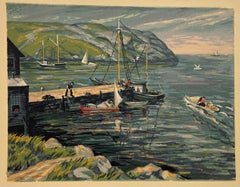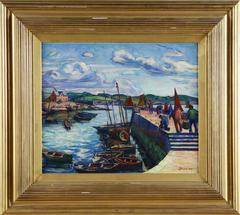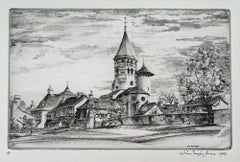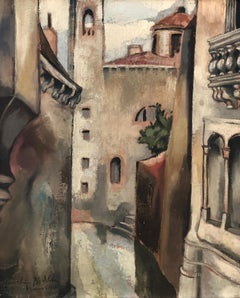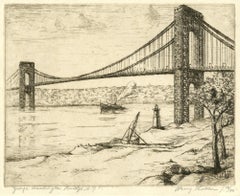Harry Shokler Art
to
1
1
Overall Width
to
Overall Height
to
2
1
2
2
2
2
1
1
1
1
1
1
2
9,961
2,752
1,376
1,372
2
Artist: Harry Shokler
Harry Shokler, Island Harbor
By Harry Shokler
Located in New York, NY
Harry Shokler used serigraphy to great advantage in this landscape. It's colorful and detailed.
It is signed in the image at the lower left. When printmakers began making serigraphs...
Category
1940s American Modern Harry Shokler Art
Materials
Screen
Lobester Fishers, Concarneau, Brittany
By Harry Shokler
Located in Fairfield, CT
Oil on canvas
Category
Mid-20th Century American Modern Harry Shokler Art
Materials
Oil
Related Items
Ceignac (Aveyron)
By John Taylor Arms
Located in Middletown, NY
Etching on antique cream laid paper with a deckle edge and an unidentified round watermark with an arm holding a torch, 3 1/2 x 5 5/8 inches (89 x 144 mm); sheet 5 3/4 x 8 3/8 inches...
Category
Mid-20th Century American Modern Harry Shokler Art
Materials
Handmade Paper, Laid Paper, Etching
Venice
By Josselin Bodley
Located in Genève, GE
Work on canvas
Molded frame in wood and gilded plaster
68 x 59 x 7 cm
Category
1920s American Modern Harry Shokler Art
Materials
Oil
Prodigal Son
By Thomas Hart Benton
Located in London, GB
A man raises his hand to his chin, his neck tilted and face turned to look at a dilapidated farmhouse, barely held together by planks of wood and exposed to the elements. Behind him ...
Category
1930s American Modern Harry Shokler Art
Materials
Lithograph
“Tidings (Carolina Memories), 1970-72” by Romare Bearden, African American
By Romare Bearden
Located in Yardley, PA
“Tidings (Carolina Memories), 1970-72” by Romare Bearden (American, 1911-1988).
A masterwork of Bearden’s mature printmaking, this work is a complex fusion of screenprint, stencil, ...
Category
1970s American Modern Harry Shokler Art
Materials
Paper, Lithograph, Offset, Screen, Stencil
$3,950
H 23.75 in W 30.75 in D 1 in
Woman and Child in the Woods - Midcentury Abstracted Landscape in Oil on Canvas
Located in Soquel, CA
Woman and Child in the Woods - Midcentury Abstracted Landscape in Oil on Canvas
Dramatic abstracted painting of a woman holding a child in the woods by Maley (20th Century). This pi...
Category
1970s American Modern Harry Shokler Art
Materials
Canvas, Oil, Stretcher Bars
$2,500
H 26.5 in W 21 in D 1 in
A Sunny 1948 Modern Lake Michigan Beach Scene by Chicago Artist, Harold Haydon
By Harold Haydon
Located in Chicago, IL
A charming, colorful 1948 Mid-Century Modern beach scene by notable Chicago artist, Harold Haydon. Depicting a sunlit beach scene with bathers and sailboats painted along the sandy ...
Category
1940s American Modern Harry Shokler Art
Materials
Paper, Oil
$850
H 16 in W 21 in D 1 in
Original Oil Painting Big Sur, Monterey California Landscape
By Virginia Shackles
Located in Soquel, CA
A beautiful American Impressionist oil seascape of the rugged Big Sur coast, Carmel California by Virginia Shackles (American, 1921-2020). The composition is pleasing with an interes...
Category
Mid-20th Century American Modern Harry Shokler Art
Materials
Canvas, Oil
$1,550
H 24 in W 30 in D 1 in
Down the River
By Thomas Hart Benton
Located in London, GB
In this sentimental work from 1939, Benton expresses his admiration for the rural lifestyle of the Midwest. He highlights the connection between man and the land by depicting two fig...
Category
1930s American Modern Harry Shokler Art
Materials
Lithograph
Farm in the Valley - Plein Air California Landscape
Located in Soquel, CA
Farm in the Valley - Plein Air California Landscape
Beautiful mid century landscape of a California farm by Baumgardner (American, 20th Century). The viewer stands on a dirt road, w...
Category
20th Century American Modern Harry Shokler Art
Materials
Canvas, Oil
Original Continental Airlines limited edition Serigraph vintage travel poster
Located in Spokane, WA
Original Continental Airlines travel poster. Linen backed in fine condition. Signed and numbered 35/50.
This original Continental Airlines poster is an artistic representation of regional destinations prominently served by Continental Airlines in the past. The design is modern and bold, showcasing a unique black-and-white theme with strong, futuristic typography and graphical illustrations. Each city is creatively depicted using stylized imagery that resonates with its character—Oklahoma City features a cowboy motif, New Orleans embraces a jazzy, cultural essence, Dallas reflects the energy of movement, and Midland/Odessa highlights industrial and oil-centric themes.
This limited-edition poster is printed in black and white. It features the destinations of Hawaii, San Francisco, Albuquerque and Portland Above each name is a design that represents each destination city.
Hawaii has rows of palm trees and hula dancers. San Francisco has rolling hills and cable cars. Albuquerque has tribal Indians dancing. Portland has the cruise shipping. This image features the Saul Bass l967 Continental logo in the design.
Continental Airlines was a major United States airline founded in 1934 and eventually headquartered in Houston, Texas.
The airline was acquired by UAL Corporation, the parent company of United Airlines, on October 1, 2010.
This is an original vintage Continental Airlines poster...
Category
Late 20th Century American Modern Harry Shokler Art
Materials
Screen
$675
H 40 in W 26.5 in D 0.3 in
DISCOVERY OF GOLD - Very Large Serigraph - WPA Artist - California Murals
By Anton Refregier
Located in Santa Monica, CA
ANTON REFREGIER (1905 – 1979)
DISCOVERY OF GOLD, 1949. Color serigraph. Signed and numbered in pencil, edition of 90. Image 23 ¼ x 21 ¾" Large sheet, 29 3/4 x 25 ¼”. Printed title...
Category
1940s American Modern Harry Shokler Art
Materials
Screen
$1,250
H 23.5 in W 21.75 in
Tugs on the Hudson
By Charles Frederick William Mielatz
Located in Middletown, NY
Drypoint etching with engraving printed in black ink on Japanese mulberry paper, 4 1/2 x 3 3/8 inches (113 x 84 mm), full margins. In superb condition. A beautiful New York City river...
Category
Early 20th Century American Modern Harry Shokler Art
Materials
Handmade Paper, Drypoint, Etching
Previously Available Items
Summer Afternoon
By Harry Shokler
Located in Milford, NH
This fine coastal oil painting was painted by American artist Henry Shokler (1896-1978). Shokler was born in Cincinnati, OH and was an active artist and pioneer in silk screen and se...
Category
1920s American Impressionist Harry Shokler Art
Materials
Canvas, Oil
George Washington Bridge, N.Y.C.
By Harry Shokler
Located in Middletown, NY
A serene view of the Hudson and the newly constructed George Washing Bridge as it appeared from Fort Washington Park in 1931, with the storied "Little Red Lighthouse" in the foregrou...
Category
Early 20th Century American Modern Harry Shokler Art
Materials
Handmade Paper, Etching, Drypoint
Walking in the Snow (Vermont village)
By Harry Shokler
Located in New Orleans, LA
Harry Shokler was born in Ohio in 1896 and died in Londonderry, Vermont in 1978. He was a pioneer in the serigraph or silk screen technique in the mid 30s. He moved to Vermont in 1...
Category
1930s American Modern Harry Shokler Art
Materials
Screen
Covered Bridge (South Londonderry, Vermont Bridge across the West River)
By Harry Shokler
Located in New Orleans, LA
Harry Shokler was born in Ohio in 1896 and died in Londonderry, Vermont in 1978. He was a pioneer in the serigraph or silk screen technique in the mid 30s. He moved to Vermont in 1...
Category
Mid-20th Century American Modern Harry Shokler Art
Materials
Screen
Harry Shokler art for sale on 1stDibs.
Find a wide variety of authentic Harry Shokler art available for sale on 1stDibs. You can also browse by medium to find art by Harry Shokler in oil paint, paint, screen print and more. Much of the original work by this artist or collective was created during the 20th century and is mostly associated with the modern style. Not every interior allows for large Harry Shokler art, so small editions measuring 17 inches across are available. Customers who are interested in this artist might also find the work of Thomas Hart Benton, Lawrence Wilbur, and Clifford Isaac Addams. Harry Shokler art prices can differ depending upon medium, time period and other attributes. On 1stDibs, the price for these items starts at $900 and tops out at $9,000, while the average work can sell for $4,950.
